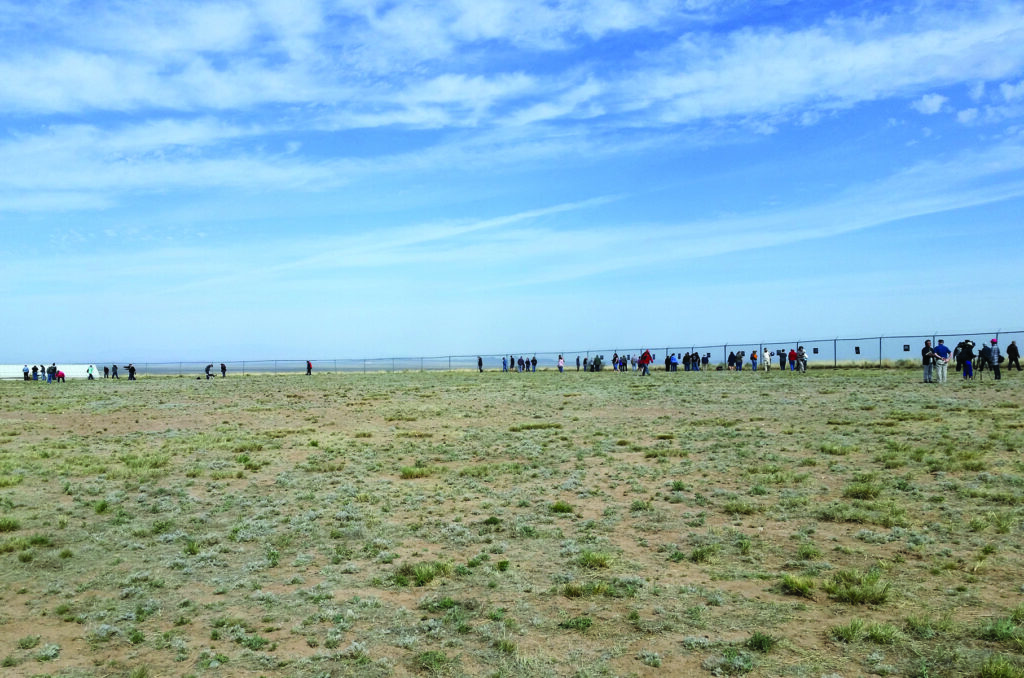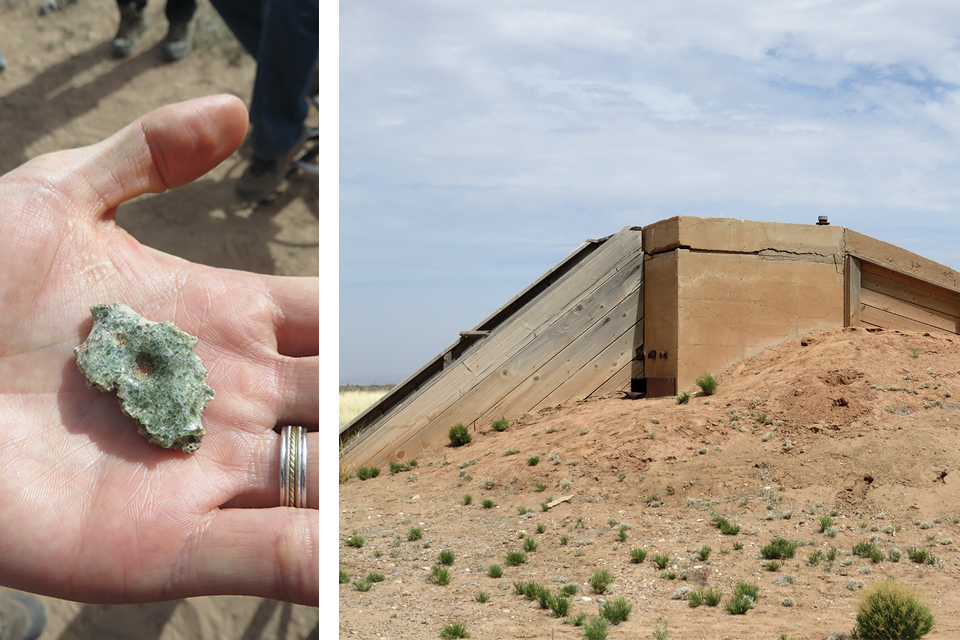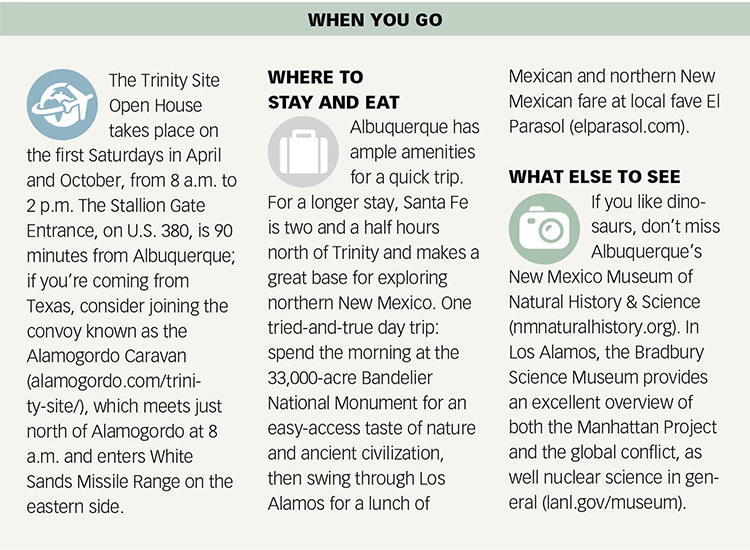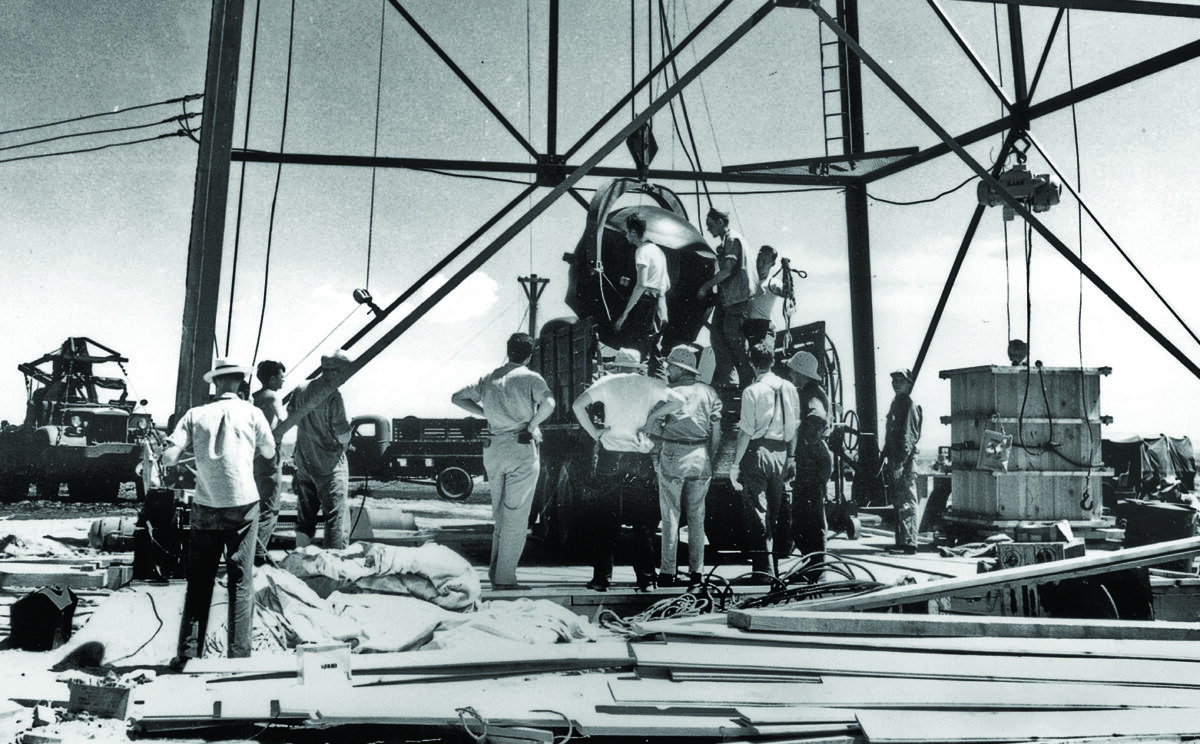IT’S EARLY MORNING on Saturday, April 4, and I’m cruising down I-25 alongside mountains, farmland, train tracks, and the gentle course of the Rio Grande. I’m on my way to White Sands Missile Range to visit a wind-worn crater. There, a fraction of a second before 5:30 a.m. on July 16, 1945, an explosion equal to 19 kilotons of TNT lit up the landscape with the daylight of 20 suns before its blast column surged thousands of feet high, sending winds that warmed distant onlookers like a fireplace. This was a test, codenamed Trinity, and with it the atomic bomb went from scientific theory to world-changing reality.
As I drive, I use my phone’s compass to play at spotting the test site. It’s still another 90 miles away, but that’s nothing given the monstrous size of the blast. Santa Fe railway engineer Ed Lane was just down the tracks from here, in Belen, when he saw the explosion. “All at once it seemed as if the sun had suddenly appeared in the sky out of darkness,” Lane recounted in Ferenc Morton Szasz’s The Day the Sun Rose Twice. “There was a tremendous white flash. This was followed by a great red glare and high in the sky there were three tremendous smoke rings. The highest was many hundreds of feet high. They swirled and twisted as if being agitated by a great force. The glare lasted about three minutes and then everything was dark again, with dawn breaking in the east.” I try to transpose this vision onto the expansive blue before me, but the desert defies all sense of scale.
The final stretch of road leading to White Sands’ Stallion Gate makes clear why the desert aptly named Jornada del Muerto—Journey of the Dead—was a natural for testing an A-bomb. To the east and west, respectively, the San Andres and San Mateo Mountains contain a 27-plus-mile flat expanse of rock, sand, and scrub punctuated only by an occasional yucca. In 1945, adjacent Socorro County had 11,422 residents—only about 6,000 fewer than today. If you want to unleash an unfathomable payload without destroying anything of value while shielding the event from the outside world yet be able to observe the blast from every angle—within easy commuting range of Los Alamos—the Jornada has it covered.

Of course, the Trinity Test was still at the mercy of the weather, war’s most irascible factor. Planners had very little historic meteorological data and, like many of New Mexico’s high deserts, the Jornada has its own particular weather patterns. In March 1945, Trinity’s new chief meteorologist, Jack M. Hubbard, had to pinpoint a window for testing—clear and dry, with calm winds and stable atmospheric temperatures. To avoid a tropical system, he recommended July 18 to 21; a higher-up set the date for July 16. “Right in the middle of a period of thunderstorms,” wrote Hubbard in his diary, “what son-of-a-bitch could have done this?” That would prove to be President Harry S. Truman, hoping for a big reveal at Potsdam. Fortunately for Truman, rain and winds subsided, delaying the 4 a.m. ignition by only 90 minutes.
This April morning the Jornada is in a haze, as it was prior to the test. I’m grateful for the softened glare as I crawl through the hour-long entry line. Fierce sun is why the site is open in spring and fall instead of the July anniversary, when temperatures in the 90s are typical.
Finally I reach the checkpoint and, after a quick reminder not to take photos anywhere other than the Trinity Site, I’m zooming past anonymous equipment shelters and silos dubbed “Permanent High Explosives Test Site.” Even as I approach the parking lot adjacent to ground zero, a line of cars is pulling out. It’s 9:30 a.m., an hour and a half after the gate opened, and I’m one of thousands already here on pilgrimage.
Army ROTC cadets point me to a parking space, and I follow the stream of visitors to Trinity’s ill-used sentinel: a rust-colored, open-ended, bus-size cylinder called Jumbo. Before the test, project scientists worried that a failed detonation would waste precious fissionable plutonium. The solution: fit the bomb inside a 25-foot-long, 10-foot-wide steel cylinder from which material could be recovered for a second test bomb. Jumbo was, as test director Kenneth Bainbridge later called it, “the physical manifestation of the lowest point in the Laboratory’s hopes.” By the time Jumbo was ready, the Manhattan Project plutonium reactors were in full swing and confidence in the weapon’s design had grown. Jumbo instead would experience Trinity 800 yards from ground zero.
The steel container survived the blast unscathed, but not the postwar years. In 1946, the army stuffed it with eight bombs that blew out both ends. It was buried until the early 1970s, when the army unearthed it; Jumbo has been at its current post since 1979.
I have to work my way through the crowd to get a moment face to face with Jumbo, which echoes with children running around its innards. It feels right to acknowledge Jumbo this way, since it resembles playground equipment and has a playful name—and given that Trinity’s success rendered it obsolete in an instant.

The procession down the dusty quarter-mile path to ground zero is subdued. Paces slow, voices hush. The final steps into the 240-foot-diameter chainlink ring feel weighted.
Here humanity unleashed the atom with a five-foot-wide spherical bomb known as the Gadget. And here the New Mexico desert proved the greater force, almost immediately swallowing the evidence. The blast made a four-foot depression in the ground, melting the sandy surface into a crust of green glass dubbed Trinitite. The tower holding the Gadget was reduced to an anonymous outcropping with a bristle of rebar. Today the crater is indistinguishable from the surrounding desert, save for the fence protecting the crater’s remaining foot of slope. Radiation levels at the site are low; an hour there delivers about one-twelfth the radiation of a chest x-ray.
The Trinity Site opened for visitors in 1953; in 1965, the army marked the center of ground zero with an obelisk of local volcanic rock. That monument has become a staple of visitor photos, though the more apt symbol is the model of Fat Man—a plutonium bomb, like the Gadget, used at Nagasaki three days after another A-bomb destroyed Hiroshima—sitting nearby on a tractor-trailer bed.
After a lap around the fence, I return to the parking lot and board the bus that runs to and from the site where workers assembled the Gadget’s plutonium core. The 1913 McDonald ranch house, 3,400 yards southeast of ground zero, is a haunting little homestead, with tumbledown fieldstone outbuildings and derelict spans of barbed wire. One of two remaining wartime structures, it feels more like a ghost town than a part of world history. The base camp, where personnel lived and worked before the test, was disassembled shortly after. Concrete shelters where scientists and others sat front row for the detonation 10,000 yards away were also demolished.
The other surviving building is an instrument bunker 800 yards west of ground zero, on the site’s access road. With one last look at Jumbo and the obelisk beyond, I drive to the bunker, clamber its sandy bank, and try to imagine its larger siblings, stuffed with physicists. North Oscura Peak looks on in the distance. I still cannot fathom light brilliant enough to illuminate its night-shrouded shoulders brighter than day.
Already this far south and with nowhere else to be, I did what a handful of Trinity scientists did post-test and head another hour south to relax and recharge at Elephant Butte Lake State Park, a 24,500-acre man-made oasis that is hopping even so early in the season. I hand over the $8 overnight fee and drive a mile or so down the dune-swept shore to a secluded inlet. There, I pitch my tent and surrender to the diluted beats of country music drifting from the campsites across the water and the occasional splash of a trout jumping at late-afternoon gnats.

Originally published in the September/October 2015 issue of World War II magazine. Subscribe here.





